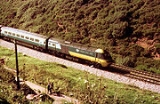
InterCity 125
Overview
British Rail
British Railways , which from 1965 traded as British Rail, was the operator of most of the rail transport in Great Britain between 1948 and 1997. It was formed from the nationalisation of the "Big Four" British railway companies and lasted until the gradual privatisation of British Rail, in stages...
's High Speed Train (HST) fleet. The InterCity 125 train is made up of two power car
Power car
A power car is a railroad vehicle that is closely related to the locomotive. What differentiates the two is their construction or their use. A true locomotive can be physically separated from its train and does nothing but provide propulsion . A power car, on the other hand, is frequently an...
s, one at each end of a fixed formation of Mark 3
British Rail Mark 3
British Rail's third design of standard carriage was designated 'Mark 3' , and was developed primarily for the InterCity 125 High Speed Train...
carriages, and is capable of 125 mi/h, making the train the fastest diesel-powered locomotive in regular service in the world. Initially the sets were classified as Classes 253 and 254. A variant of the power cars operates in Australia as part of the XPT.
After three decades, the majority of the HST fleet is still in front-line revenue service under privatisation
Privatisation of British Rail
The privatisation of British Rail was set in motion when the Conservative government enacted, on 19 January 1993, the British Coal and British Rail Act 1993 . This enabled the relevant Secretary of State to issue directions to the relevant Board...
, and while the InterCity 125 brand name is rarely mentioned officially by the private Train Operating Companies
National Rail
National Rail is a title used by the Association of Train Operating Companies as a generic term to define the passenger rail services operated in Great Britain...
(TOCs), the HST still forms the backbone of express services on several British main lines.

